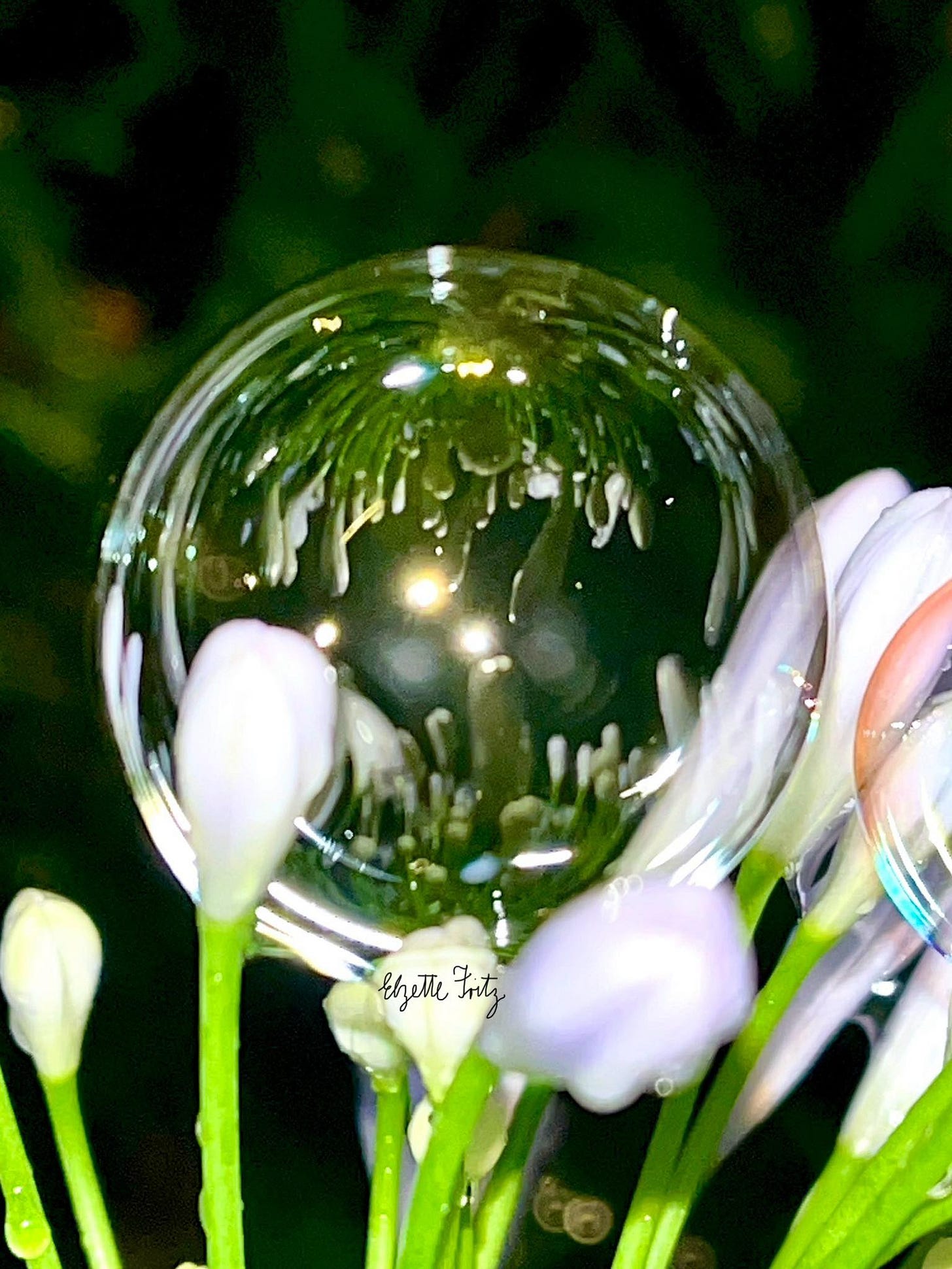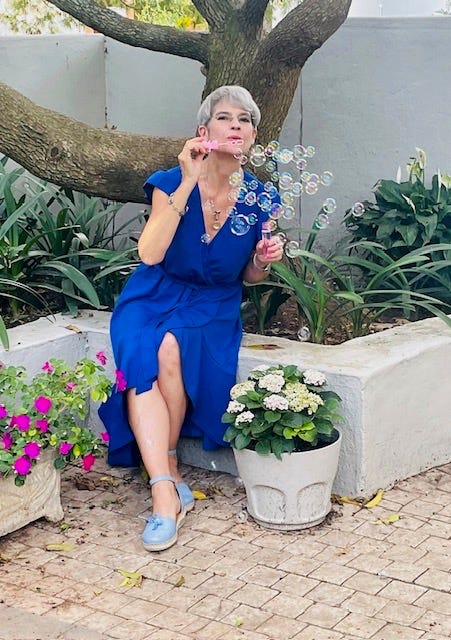Why blow bubbles? Accessing sparkles after storms and opening space for deeper breathing
By Elzette Fritz, Educational Psychologist
Introduction
In my practice as an educational psychologist, I often feel most challenged by clients, young and old, presenting with a despondent, dissociative trauma response. I am familiar with this response within myself and know how frustrated I feel when the world feels overwhelming and I feel stuck in my sense of despair. I started blowing bubbles for fun, curious about where they might float and intrigued by the rainbow colours that reflected a magical and safe world. I subsequently wondered how it may translate into my psychology practice.
Clients who bring little resources and repeatedly answer “I don’t know” to basic questions, presenting with a vacant stare and little to no affect, present with a dorsal vagal central nervous system response, referring to the polyvagal theory of Stephen Porges. This response requires innovative ideas to create gentle movement which can also enhance a trusting relationship between the client and therapist. I was therefore delighted to witness the ease with which clients could be enticed into movement through the process of blowing and catching bubbles and how this process enabled a sense of safety, stabilization and resource activation.
When Amy (8 years old) came to see me, due to her telling her mother that she no longer wanted to live, it was evident that the violent fighting between her parents, and their subsequent separation, had left her feeling despondent, at a loss for joy and disconnected from her surrounding world. She started wetting her bed and did not want to go to school. I needed to engage her in non-threatening movement, that would establish a connection between us and her surrounding world and would enable us to gain access to the world of her imagination. I was therefore guided by her autonomic nervous system response, which informed me of how play could be used in the therapeutic process.
Polyvagal theory – from hypoactivation as a trauma response to movement in play
Polyvagal Theory, developed by Stephen Porges (2011), is a neurobiological framework that helps in understanding the autonomic nervous system's role in regulating our responses to stress and trauma. It posits that the autonomic nervous system consists of three interconnected subsystems, each associated with different states of arousal and social engagement. The three subsystems are the ventral vagal, sympathetic, and dorsal vagal systems. The dorsal vagal system, the most primitive response, is one of the key components of the Polyvagal theory, particularly in the context of trauma. When an individual experiences extreme stress or trauma, the dorsal vagal system can be activated. This system is responsible for the "shutdown" response, leading to symptoms such as dissociation, immobilization, and a sense of helplessness and hopelessness. In this state, the individual may feel disconnected from the surroundings and even from bodily experiences. This response is evolutionarily older and is often associated with playing possum in response to a perceived life-threatening situation.
The concept of the "window of tolerance" is a crucial aspect of the Polyvagal theory, as it relates to an individual's capacity to manage stress and trauma. The Window of Tolerance (Siegel, 2020) describes the best state of 'arousal' or stimulation in which we can function and thrive in everyday life, capable of learning effectively, playing, and relating well to ourselves and others. When stress or trauma pushes a person outside of this window, one can experience either hyperarousal (fight or flight) or hypoarousal (dorsal vagal shutdown). Effective therapy and trauma recovery entails enabling individuals to expand their window of tolerance, allowing them to better regulate their autonomic nervous system and respond to stressors in a more adaptive way whilst connecting with others for support as well as accessing inner strength.
Blowing bubbles to connect with breathing
The autonomic nervous system can be activated through breath, movement and touch (Van der Kolk, 2014). Engaging in playful activities, such as blowing bubbles, the ventral vagal branch of the autonomic nervous system can be activated. This branch promotes a state of calm and social engagement, fostering a sense of safety and connection, especially as it involves focused breathing, which is visible through the manifestation of bubbles in the air.
Breath provides direct access to the autonomic nervous system and is a powerful means of enabling a sense of safety and connection to the internal world (Dana & Porges, 2018), especially when the external world feels scary. A breath of fear and a sigh of relief communicate the needs of the autonomic nervous system. By consciously becoming aware of the rhythm of our breathing and the sensations in the chest, an individual can connect with the ventral vagus nerve as the type, rate and inhale/exhale ratio of the breathing pattern changes. By blowing bubbles, through slower, prolonged, resistance breathing, the parasympathetic (rest and digest) activation can be engaged, whilst rapid, irregular breathing with a sharp inhalation engages the sympathetic nervous system.
Due to the type of exhalation required, blowing bubbles can therefore serve to reactivate the person feeling frozen and numb in a dissociative state, whilst also serving to calm a person who feels frantic in a fight or flight response. Amy was curious when I provided blowing bubbles as an option of engagement in my office and readily stood up from her previously slumped position. We took turns blowing bubbles in my office and she enjoyed the suggestion of catching bubbles on her fingers, reaching up towards the sky which opened up her chest for deeper breathing.
Bubbles serve to remind one of a time of innocence and freedom in movement as eyes follow the floating of bubbles up towards the sky. The act of reaching out towards the bubbles is instinctual and can be a precursor towards integrating yoga later on in therapy. In yoga, breath and movement can engage the client in becoming more embodied and mindful of internal experiences whilst being aware of their grounding in the present moment. In the face of trauma, accessing imagination is challenged (Van der Kolk, 2015) and the rainbow colours reflected in the sunlight can invite the imagination to open up. Connecting with a safe space in the inner world serves to enhance inner strength and provides hope, enabling mental flexibility to make the necessary changes to be free from the grips of trauma experiences.
I asked Amy if we could create her inner bubble of safety, which could protect her when she felt unsafe. Amy wanted to create her bubble by using clay and proceeded to take a variety of colours which she mixed. Considering the characteristics of creative interventions (Malchiodi, 2008) I first wanted to establish affect regulation before engaging Amy in the externalization of her experiences in her family.
We discussed how, when breathing out, she could imagine creating her bubble whilst hugging herself to establish a sense of safety in the here and now, while the colours could remind her of joyful experiences from the past and to come.
Conclusion
In the whirlwind that is modern life, such simple acts of play and creative engagement offer a powerful antidote to stress, and emotional turmoil and serve to engage with traumatic experiences in a contained and safe manner. Rooted in the Polyvagal Theory, engaging with bubble blowing presents with numerous possibilities considering breath, movement and opening imagination which enable greater regulation of the autonomic nervous system. Creative play reminds us that, amidst the chaos and the storms of life, there exists a pathway to inner peace and creativity as the focus shifts from the shadows of despair to the rays of light reflected in a raindrop or a bubble floating on a course of exploration.
N.B. Names have been changed to protect confidentiality.
References
Dana, D. & Porges, S.W. (2018). The polyvagal theory in therapy: Engaging the rhythm of regulation. New York: W.W. Norton & Co Inc.
Malchiodi, C.A (2008) Creative interventions and childhood trauma. In C.A. Malchiodi (Ed.), Creative interventions with traumatized children (pp.3-21). New York: The Guilford Press.
Porges, S.W. (2011). The Polyvagal theory: Neurophysiological foundations of emotions, attachment, communication, and self-regulation. New York: WW Norton & Co.
Siegel, D.J. (2020). The developing mind. How relationships and the brain interact to shape who we are (3rd ed). New York: Guilford Press.
Van der Kolk, B. (2015). The body keeps the score. Brain, mind, and body in the healing of trauma. New York: Penguin Books.
Dr. Elzette Fritz, Educational Psychologist
Leeuwenhof Akademie Private School
Supervisor – Department of Educational Psychology, University of Johannesburg
Co-Director MEISA (Milton Ericksonian Institute of South Africa), South Africa
International accredited Ego state therapy therapist, supervisor and trainer.






